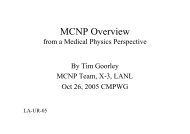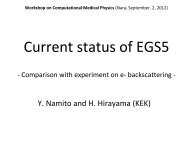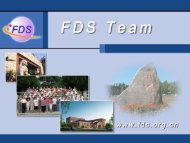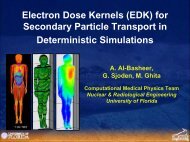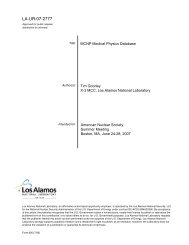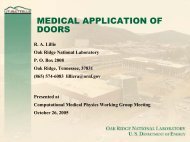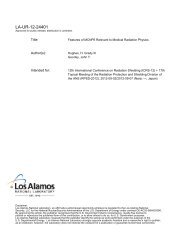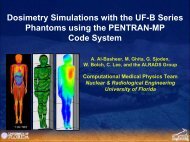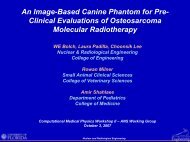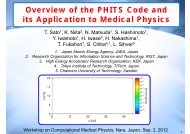LA-UR- 05-7964 - Computational Medical Physics Working Group
LA-UR- 05-7964 - Computational Medical Physics Working Group
LA-UR- 05-7964 - Computational Medical Physics Working Group
You also want an ePaper? Increase the reach of your titles
YUMPU automatically turns print PDFs into web optimized ePapers that Google loves.
<strong>LA</strong>-<strong>UR</strong>-<br />
Approved for public release;<br />
distribution is unlimited.<br />
Title:<br />
Author(s):<br />
Submitted to:<br />
Los Alamos National Laboratory, an affirmative action/equal opportunity employer, is operated by the University of California for the U.S.<br />
Department of Energy under contract W-74<strong>05</strong>-ENG-36. By acceptance of this article, the publisher recognizes that the U.S. Government<br />
retains a nonexclusive, royalty-free license to publish or reproduce the published form of this contribution, or to allow others to do so, for U.S.<br />
Government purposes. Los Alamos National Laboratory requests that the publisher identify this article as work performed under the<br />
auspices of the U.S. Department of Energy. Los Alamos National Laboratory strongly supports academic freedom and a researcher’s right to<br />
publish; as an institution, however, the Laboratory does not endorse the viewpoint of a publication or guarantee its technical correctness.<br />
Form 836 (8/00)
<strong>Medical</strong> <strong>Physics</strong> SDEF Sources<br />
By Tim Goorley, X-5<br />
<strong>LA</strong>-<strong>UR</strong>-<strong>05</strong>-<strong>7964</strong>
Abstract<br />
While it is important to accurately represent the appropriate<br />
geometry for <strong>Medical</strong> <strong>Physics</strong> simulations, it is just as<br />
important to accurately represent the radiation source. The<br />
following slides give several examples of photon and<br />
neutron sources encountered in <strong>Medical</strong> <strong>Physics</strong><br />
applications. These examples show how to construct the<br />
SDEF card in MCNP to simulate various radiation sources.
SDEF Sources<br />
• Co-60 Photon Source (Exercises 1-3)<br />
• Epithermal Neutron Beam (Exercises 4-5)
Co-60 Photon Source<br />
• Photon Energies: 1.173 MeV, 1.332 MeV<br />
• Both energies equally probable<br />
• Isotropic<br />
• Exercise 1: Point Source at origin<br />
• Exercise 2: Source Sphere (equally prob)
Solutions<br />
Simple input deck for Co-60 point or sphere source<br />
100 1 -1.0 -10 imp:p=1<br />
200 0 10 imp:p=0<br />
10 so 5.0 $ Sphere at origin, 5 cm radius<br />
c sdef erg=d1 cel=100 par=2 $ What would this line do? [Point Source @ origin]<br />
c sdef erg=d1 cel=100 par=2 rad=2.0 $ What would this line do? [Thin Shell Src]<br />
sdef erg=d1 cell=100 par=2 rad=d2 $ This is a homogeneous sphere source<br />
si1 L 1.173 1.332 $ Discrete Co-60 Energies, in MeV<br />
sp1 D 1.0 1.0 $ Equiprobable<br />
si2 H 0 2.0 $ Radial Bin Distribution from 0.0 cm to 2.0 cm<br />
sp2 -21 2 $ Power law sampling to 2 nd power, for spherical sources<br />
mode p $ Photon Source<br />
nps 50<br />
m1 1001 2 8016 1 $ Water, note molecular formula is atom fraction<br />
• Exercise 3:<br />
Co-60 Seed Source<br />
– 2 hemispheres rad = 1.0 cm<br />
– 1 cylinder rad = 1.0 cm, length = 1.0 cm<br />
– Hint: Use Cell Acceptance
• Exercise 3<br />
Solutions<br />
SDEF ERG=D1 RAD=D2 CEL = 100<br />
• What would the following lines do?<br />
SDEF ERG=D1 CEL=100<br />
SDEF ERG=D1 RAD=2.0
Exercise 3 Input Deck<br />
Simple input deck for Co-60 Seed source<br />
100 1 -1.0 -10:-20:-30 imp:p=1<br />
200 0 10 20 30 -40 imp:p=1<br />
300 0 40 imp:p=0<br />
10 s -0.5 0.0 0.0 1.0<br />
20 s 0.5 0.0 0.0 1.0<br />
30 rcc -0.5 0.0 0.0 1.0 0.0 0.0 1.0<br />
40 so 5.0<br />
c sdef erg=d1 cel=100 par=2 $ What would this line do?<br />
c sdef erg=d1 cel=100 par=2 rad=2.0 $ What would this line do?<br />
sdef erg=d1 cell=100 par=2 rad=d2<br />
si1 L 1.173 1.332<br />
sp1 D 1.0 1.0<br />
si2 H 0 2.0<br />
sp2 -21 2<br />
mode p<br />
nps 50<br />
m1 1001 2 8016 1<br />
Exercise 3 Plotting<br />
• These Vised Source plotting pictures show the<br />
difference between SP2 –21 2.0 (left – correct)<br />
and SP2 – 21 1.0 (right – not homogeneous)<br />
• Do you see a difference?<br />
Different colors for different energies
Neutron Beam<br />
• Monoenergetic Epithermal N’s – 5.0 KeV<br />
• Beam 5.0 cm radius<br />
• Travels from –x to +x [monodirectional]<br />
• Starts at x= -5.0<br />
• Pass through a 1 cm rad ball of water at origin<br />
• Exercise 4: Monodirectional beam
Neutron Beam – Ex 4 soln<br />
• Exercise 4<br />
SDEF POS= -5.0 0.0 0.0<br />
VEC=1 0 0 $ What if no vec card?<br />
AXS=1 0 0 $ What if no axs card?<br />
DIR=1.0 $ What if no dir card?<br />
RAD=D3<br />
ERG=0.0<strong>05</strong> PAR=1<br />
SI3 H 0.0 5.0<br />
SP3 -21 1
Exercise 4 Plotting<br />
• These Vised Source plotting pictures show the<br />
difference between SP2 –21 2.0 (left – not<br />
correct) and SP2 – 21 1.0 (right – correct)<br />
• Do you see a difference?
Exercise 4 Input Deck<br />
This is a simple monodir neutron beam problem<br />
C Little geometry is needed<br />
100 1 1.0 -10 imp:n=1<br />
101 0 10 -20 imp:n=1 $ What if imp:n=0?<br />
102 0 20 imp:n=0<br />
10 so 1.0<br />
20 so 20.0<br />
mode n p<br />
m1 1001 2 8016 1<br />
sdef pos -5.0 0.0 0.0<br />
axs 1 0 0 $ What happens if no axs?<br />
C If no axs, source becomes a spherical source<br />
vec 1 0 0 $ What happens if no vec?<br />
C If no vec, no reference direction for particle direction<br />
dir 1.0 $ What happens if no dir? [isotropic source]<br />
erg=0.0<strong>05</strong> rad=d4 par 1<br />
ext=0.0 $ A disk source is a degenerate cylinder source<br />
si4 H 0.0 5.0<br />
sp4 -21 1 $ Power Law, power=1 for disk sources<br />
print<br />
nps 50
Exercise 5<br />
• Add beam divergence of 5°<br />
• Think about difference between:<br />
Y<br />
A B<br />
5°<br />
X<br />
• Both are possible in MCNP (Do Both!)<br />
5°
Neutron Beam – Ex 5 soln A<br />
Exercise 5<br />
SDEF POS= -5.0 0.0 0.0<br />
VEC=100 8.74 0.0<br />
AXS=1 0 0<br />
DIR=1<br />
PAR=1<br />
RAD=D3<br />
ERG=0.0<strong>05</strong><br />
Exercise 5<br />
SDEF POS= -5.0 0.0 0.0<br />
VEC=100 8.74 0.0<br />
AXS=100 8.74 0.0<br />
DIR=1<br />
PAR=1<br />
RAD=D3<br />
ERG=0.0<strong>05</strong><br />
The difference between these two is the cross section of<br />
the beam. The one on the right has a circular cross<br />
section, the one on the left has an elliptical cross section
Beam Cross Section<br />
AXS & VEC different AXS & VEC same<br />
Which did you intend?
Neutron Beam – Ex 5 soln B<br />
Exercise 5<br />
SDEF POS= -5.0 0.0 0.0<br />
VEC=1 0 0<br />
AXS=1 0 0<br />
DIR=0.9962 $ = cos(5 deg*pi/180)<br />
PAR=1<br />
RAD=D3<br />
ERG=0.0<strong>05</strong>



